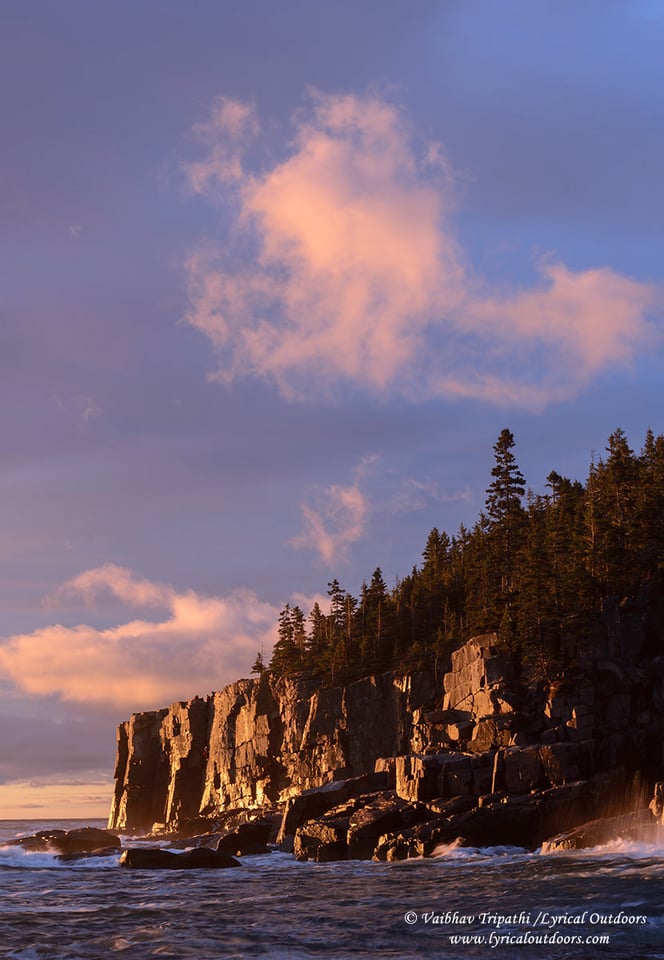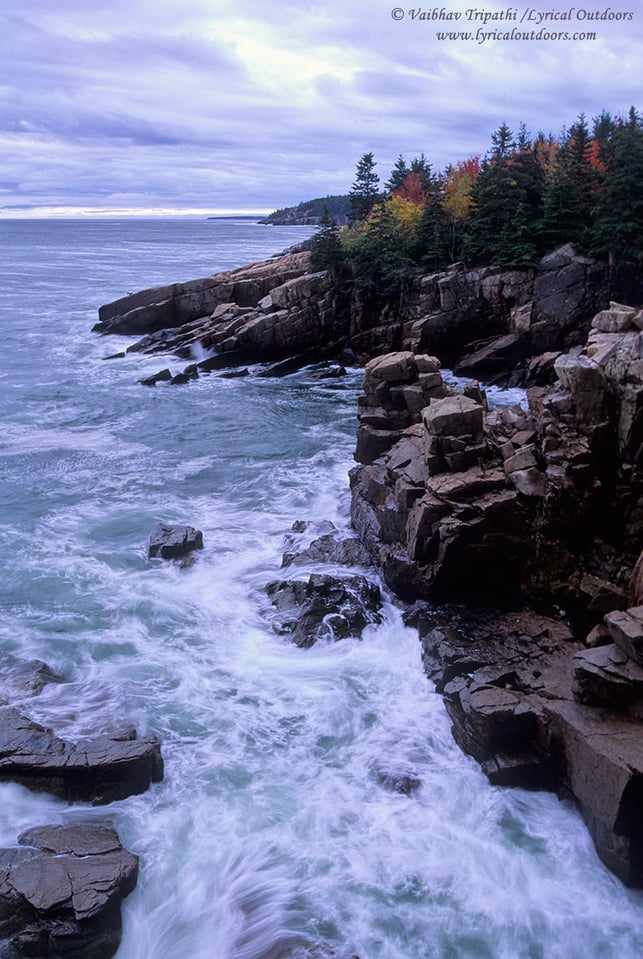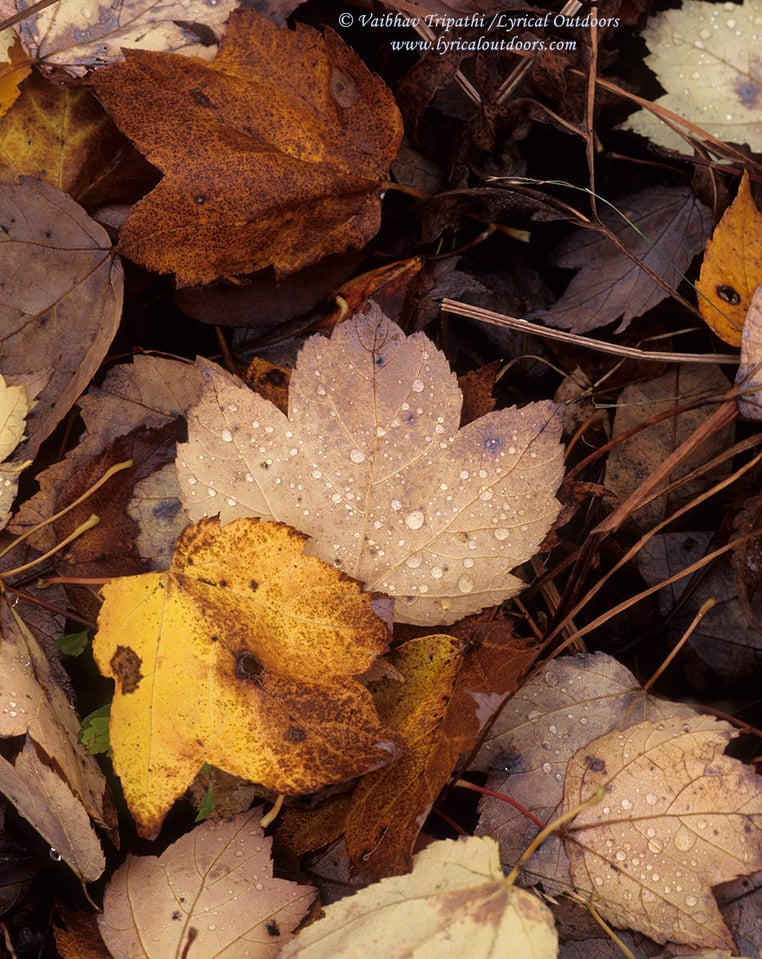As the maximum temperatures slowly drop below 40 F (6 C), the ephemeral autumn silently gives way to a long winter in New England; but not before weaving its colorful magic yet again. This year, I was fortunate to witness this magic from up close during a weekend camping trip in Acadia National Park in Maine. Colors in Acadia usually peak around mid-October, which roughly coincided with my trip and I found the foliage in good shape: either peaking or just past peak. Moreover, the forecast called for cloudy skies and occasional rain with breaks both in morning and evenings, which meant I can photograph all day: golden light at the fringes and soft, overcast light in between. My equipment was a Nikon D610 and a Nikon F100 (loaded with Velvia 50) along with the a host of Nikkor lenses (with polarizers): Nikon 24mm f/2.8 AI, Nikon 24-120 f/4G VR, Nikon 18-35mm, Nikon 50mm f/1.2 AIs, Nikon 85mm f/1.8G and Nikon 70-200mm f/4G VR.

The Park Loop Road inside Acadia runs in a clockwise fashion around the Cadillac Mountain and other hills (essentially from Bar Harbor to Seal Harbor and back). The stretch along the Atlantic coast is a one way drive (north-south) with parking allowed in the right lane. This meant I could stop whenever I found something of interest, take my time refining compositions and further explore the area. My first stop was at Beaver pond where the hillside was a mix of orange and yellows, glowing in the soft overcast light. After spending around 30 minutes at Beaver pond, I drove further to find beautiful bare birch trees standing out prominently from the reds and yellow leaves. In the afternoon, this stretch of the road is in the shadow of Cadillac Mountain and as a result light remains soft throughout, which suits intimate compositions highlighting color and texture.



Being next to the Atlantic, this side of Acadia receives the early morning light and boasts some of the best locations for sunrise shooting e.g. Otter Cliffs, Sand Beach, Thunder Hole etc. I used the afternoon to get acquainted with the area and scout for the sunrise shoot next day. It was around sunset at Sand Beach, when the clouds lit up with the last light of the day and I made a memorable, unique image at this well photographed location.

Cloud bank and waves at sunset, Sand Beach, Acadia NP (Fuji Velvia 50)Driving back to the campground, it was well past sunset into the blue hour and just past Otter Cliffs, I was moved by the clouds and reflections in the Otter Cove. A 20 second exposure at ISO 400 (Nikon D610) really captured the moment and colors (emotions) as I perceived that evening.
It rained during the night and by next morning, the sky had cleared towards east with some lingering clouds (promising a colorful sunrise). At Otter Cliffs, after clicking the clichéd wide angle composition, I switched to a 70-200 mm lens and zoomed in to isolate the golden cliffs with floating clouds painted by morning light.


Otter Cliffs in the Morning

Lit cloud and Otter Cliffs
After the sunrise shoot, I quickly drove around to start again from the Northern end of the park loop road (remember it is a one-way). The idea was to photograph the coastline in low angled morning light but by the time I was again at Beaver pond a cloud bank had moved in resulting in overcast conditions. Immediately, I switched gears and once again focused my attention on the interesting juxtapositions of color and texture, accentuated by overnight rain. I spent quite a while photographing and exploring the region, including the rocky Maine coastline. Overall, it was a good morning for photography.



It was around 10 in the morning when I wrapped up my camp site and ventured on to explore the west side of the Cadillac Mountain accessed by the south to north stretch of the Park Loop road. Here the sound of ocean waves crashing on the rocks is replaced by the rhythmic ripples of Jordan Pond, Bubble Pond and Eagle Lake. There are plenty of hiking trails as well as over 40 miles of carriage roads that take you deep into the park. The latter can be explored only by carriages, bikes or on foot. Unfortunately, I didn’t have long enough to explore the carriage roads this time around and it is something I look forward to do during my next visit to Acadia.
I spent couple of hours around Jordan and Bubble ponds and found some nice fall hues. Additionally, I found some exceptional patches of color along the Park Loop road near Bubble pond. However, this stretch of the road is not a one-way and it is very hard to stop except at marked turnouts. I parked at one such turnout and walked about half a mile on the edge of the road to finally find a spot, from where I could make a photo capturing the kaleidoscope of colors in the woods. By the time, I was content, it was well past mid-day and I had two more locations on my agenda: Dear Brook Road and the Cadillac Mountain summit. The former is further west and the foliage there was well past peak with many bare trees. I climbed down couple of rocks along the swift flowing stream and found a nice contrast of water and color.




Next, I drove up the Cadillac Mountain road, the highest of the park and as I gained height, the vast expanse of this beautiful island unfolded in front of me. From the summit, I got a bird’s eye view of colorful hill slopes I was driving through towards east. After a long overcast day, the sun was finally breaking towards west, which prompted me to act rather quickly. I scouted around the summit, converged on a composition and then waited braving the cold wind. Finally, about 30 minutes before posted sunset time, the sun broke free albeit briefly but long enough to press the shutter and freeze the striking moment.



After enjoying about 28 hours in Acadia National Park, it was about time to start the long drive back to near Boston. While still in the park, I kept scanning the sky, ready to stop at the slightest warning of a colorful sunset, which came fairly quickly. On a hunch, I took a detour to a turnout on the road towards the visitor center, from where I had spotted vivid foliage in the valley below, the day before. It proved to be a good call and I arrived in time to make one of my favorite images from the trip, which graces the top of this article. It was very windy and instead of fighting the wind by boosting ISO, I made a conscious choice of using a slow shutter speed (Velvia ISO 50) and capture the motion blur to add a bit of vitality to the composition. It was a tiring 5 hours of drive back and dinner was really late that day but I couldn’t care less. I hope you like the images.
the Cobble Beach looks horrible…….
Wow! These Velvia 50 images look outstanding! Even with a good DSLR like the D610 or D810 it is hard to obtain such wonderful colors in landscape scenes. May I ask you which type of scanner you used? How large can you go in a printing process using the Velvia scans? By the way: I hope to see more film based stories at Photographylife.com in future.
Thanks for your comment. I am glad you liked the photos.
I use a Nikon Coolscan 5000 with Nikon Scan as the only software. This combination scans slides at 4000 dpi, which gives me a nice 12×18 (or 11.5 by 17.5 after cropping) 16 bit tiff at 300 dpi. For comparison the native resolution of a D610 file is 13.5 by 20 at 300 dpi .
The scanned Velvia 50 looks almost identical to a D610 file and I guess I can easily make a nice 20×30 print using it. I have never drum scanned my slides before but I intend to do that soon and compare the result with my Nikon Coolscan 5000.
– Vaibhav
Who said film was dead? They should look at these images, excellent work.
Thank you for sharing with us your work efforts, and the beautiful results it gave you – delicate and emotioning photographs!
Still, it has been worth to take time to read your travel story too, it aids to imagine yourself like you, while scouting for the composition you had dreamed, and looking for.
Sebastiano
Thanks for the kind words and taking some time in reading the travel story. I am glad that you liked the photos.
– Vaibhav
Thank you for sharing your great images! As someone who has been experimenting with film (as an addition to my digital work), I really appreciated seeing your use of Velvia. There is a beauty to it that is so simple, and these days it is relatively inexpensive to produce when compared with a brand new digital camera. My one question is whether you used matrix metering for the Velvia exposures. It would be great to see more film work on this site. Thank you again!
I use both matrix and spot metering. The latter gives me more confidence and I usually do not bracket (or bracket just one side in tricky lighting) when using it. With matrix metering, I try to bracket a bit more, may be like 0.5 stops on either side. On an overcast day while shooting low contrast scenes, matrix metering on F100 worked well for me this time.
well, in any event, they really are beautiful. Trees don’t grow where I am , its too cold, so they’re all magical to me. Especially pictures like these!
:)
Ron
Good shots. However, the third one, with the label of birch trees is mis-labelled. Those are aspens, not white, or paper, birch. Just sayin’ ….
Nope. Those are definitely birch trees. Just sayin’…
Loved your photos and the fact you are using Fuji Velvia. I still have about 20 rolls left over from my days of shooting with film. I also loved the way my pictures looked on the slide screen. Velvia provided great color saturation! You have given me a wonderful reason to get out my old film camera — I wonder if it still works. Thanks for sharing your photos from Acadia…I must go there one of these days.
I am glad that you liked the photos. 20 rolls of a film is quite a bit. It will keep you busy for some time I believe and I am sure your old film camera will work, especially if it is more mechanical than electronic. I have a Nikon FE that works flawlessly every time I press the shutter.
– Vaibhav
great photographs vaibhav! absolutely stunning. I suppose you had one amazing adventure that is sure to last a lifetime. And yes, your photographs clearly show nature at its best.
Great Photos Vaibhav. You should tell us more about your composition technique. You have captured wonderful scenes. What I find is that even though a scene may be beautiful, you have to capture all the right aspects otherwise it turns out to be quite ordinary. In one place, all the leaves may be of one particular color, but to capture such a range of colors you have to have a perfect vantage point or a perfect focal range of the lens.
You bring out a very important aspect of photography on which numerous pages have been written before and will be written in future. Here, I will give a quick reply that works well for this ‘comments’ section.
My personal mantra for a good composition is selectivity i.e. not trying to capture everything in front of you. And as you said it, which focal length to use really matters as that defines your perspective and the front to back relations among the elements of your image. When I find a scene, I usually see it from my mind’s eye, which means I imagine looking at it using a certain focal length. Ofcourse there are changes later but I know (not always) what I am after.
– Vaibhav